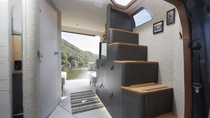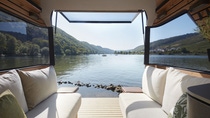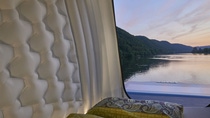Automotive & Transportation
4 ways to improve RVs for a post-pandemic world
While COVID-19 has sent some industries to a screeching halt, others have emerged even stronger than before. The RV industry, for one, is positioned to grow rapidly in the wake of the pandemic, as millions of travelers forgo far-flung destinations in favor of road trips closer to home. In fact, according to the RV Industry Association (RVIA), 46 million Americans are planning to take an RV trip in the next 12 months. RVIA also reports that more RVs were shipped to dealers in July 2020 than any month over the past 40 years. At the same time, RV rental companies Outdoorsy and RVshare have both booked three times the trips they did last year in the first half of 2020.
With a soaring customer base, manufacturers that embrace creative solutions have a unique opportunity to make RV travel more enjoyable, affordable and sustainable than ever before.
Here are four considerations to keep in mind:
1) SAFETY
Safety on the road is an unquestionable priority, and there’s a lot that can go wrong. Fortunately, technology helps ensure your RVs are better equipped to handle everything from kitchen fires to thunderstorms.
BASF offers a wide range of solutions to build the safest vehicles possible. SLENTEX®, for instance, provides heat protection to batteries and engine compartments, as well as interior features like ovens. Made of non-combustible materials, the high-performance insulation is capable of effectively preventing the spread of sparks or fire.
Safeguarding RVs from the elements is also crucial. Solutions like the water-resistant Elastollan® thermoplastic polyurethane finish formulates a protective wall against water and wind. Exterior materials like Ultramid® polyamide, a glass fiber reinforced material, is crash-resistant and can further strengthen the vehicle.

2) COMFORT
RVs and camping in general have both come along way — and neither are slowing down. Grand View Research predicts the U.S. glamping market size will swell to $4.8 billion by 2025. This signals tremendous opportunity for RVs that offer a plushier experience than their competitors. The possibilities are endless, especially with a versatile solution like polyurethane foam.
Soft, elastic polyurethane foams are perfectly suited to RV interior furnishings. Elastocoat® C spray gel offers temperature-regulating properties to keep cushions and mattresses cool during the scorching summer months. Elasticized material like BASF’s Infinergy® is another exciting option. The world’s first expandable thermoplastic polyurethane (E-TPU), Infinergy is both high-strength and light weight. It applies pressure-point relief while saving weight and enhancing durability.
Beyond ensuring a good night’s sleep, polyurethane foams also make the vehicle more comfortable through superior sound and thermal insulation. The Elastoflex® W flexible foam system performs as a sound absorber that significantly reduces reverberation effects. It also dampens sounds from outside the car through visco-elastic energy dissipation. Designed to resist high temperatures, Elastoflex W is an ideal NVH and heat management system.
Elastoflex® PU is also suited to seating, thanks to its durability and elasticity. The robust foam cushioning retains its comfort and shape, even after prolonged weight stress. It also contains a low-odor property, which improves interior air quality. Elastoflex was recently used to develop high-end seating for Yutong Bus Co., the world’s leading bus manufacturer.
When considering the comfort of your RV, don’t overlook other important details, like interior surface coatings. Flexible, integrative skin foam like Elastofoam® is not only soft to the touch, but also bolsters surfaces against scratches and abrasion — an ideal choice for the rough and tumble life on the road.

3) SUSTAINABILITY
In 2016, Millennials – people born between 1981 and 1996 – became the most populous generation in the workforce, according to Environment Journal. With their increasing spending power, these consumers have made a rapid entry into the RV market and it can no longer be viewed as an activity just for retirees. However, not just any old RV will do, and there’s no better time for manufacturers to use innovative solutions to appeal to this notoriously nitpicky demographic. How?
Start with sustainability, which matters to Millennials — 75 percent are willing to pay more for sustainable products, according to a report by Environment Journal. BASF chemistry helps the RV industry capitalize on this trend through lightweighting, one of the most exciting and profound developments in sustainable transportation. By swapping out metals and woods for composite plastics, manufacturers are able to produce lighter and more fuel-efficient vehicles with typical weight savings ranging from 20 to 50 percent. This is especially meaningful when you consider that 75 percent of fuel consumption is related to vehicle weight.
BASF offers an extensive portfolio of composite plastics, including continuous fiber reinforced thermoplastics. BASF was even able to develop a grille opening enforcement (GOR) — in cooperation with Ford and Magna — made entirely of carbon fiber composite. It was 24 percent lighter than the former plastic-metal hybrid design.

4) AESTHETICS
Millennials are the generation that fully embraced #vanlife, capturing and sharing images of their scenic road travels on social media. Aesthetics are important, and RVs are considered not just a means of transportation, but an expression of individual taste and personality. While previous solutions may have limited RV design, chemistry-driven innovation now offer manufacturers the ability to make a lasting impression.
While RVs traditionally rely on white or cream paintwork on the exterior to avoid overheating in the summer, that doesn’t mean you can’t explore alternative colors and keep your customers cool at the same time. The technology is certainly there. For instance, BASF and HYMER teamed up last year to create the VisionVenture concept campervan, which was a distinct green-grey color. The paint, based on new Chromacool temperature-management technology, reflects the sun’s infrared light and subsequently reduces the build-up of heat in the vehicle body. With less energy required for air conditioning, the overall fuel consumption is reduced. Chromacool paints will soon be available in a wide selection of colors.
Personalization doesn’t need to be restricted to the RV exterior. Inside, solutions like Haptex® polyurethane perfectly imitates leather, right down to the soft touch. It’s available in a wide range of colors and textures.
COVID-19 has radically changed the travel industry. As demand for RVs continues to surge, manufacturers are meeting the evolving needs of a growing customer base by offering innovative solutions in safety, comfort, aesthetics and sustainability. As leaders in product and technical development, BASF offers its customers deep-rooted market knowledge and robust resources throughout every stage of production. We’re excited to continue our work in the automotive and RV spaces to bring new ideas to life.
